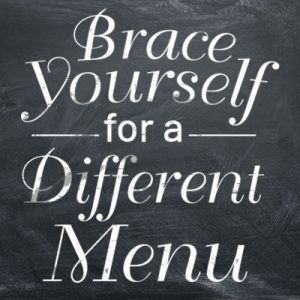Brace Yourself: It’s Time for a New Menu
 According to the American Association of Orthodontics, over four million people in the United States are undergoing orthodontic treatment at any given time, and about 25% of those people are adults. These statistics include different types of orthodontic treatments, such as clear aligner systems that have become increasingly popular in recent years.
According to the American Association of Orthodontics, over four million people in the United States are undergoing orthodontic treatment at any given time, and about 25% of those people are adults. These statistics include different types of orthodontic treatments, such as clear aligner systems that have become increasingly popular in recent years.
Clear aligners can be removed to eat, drink, and clean teeth, so diets are not as limited for patients that use them, but Dr. Ceneviz advises wearers of more traditional braces (constructed with brackets and wires) to modify their diets for the duration of treatment to avoid damaging their hardware and their teeth!
Beverages to Avoid with Braces
The list of beverages to avoid with braces is shorter than the list of restricted foods, so let’s get beverages out of the way first! There are two key categories for restricted beverages: fizzy and acidic. Avoid sodas and other carbonated beverages, natural fruit juices, and sports drinks—all can be very acidic and high in sugar, which encourages enamel erosion and tooth decay—this is true for all teeth, but especially ones with braces!
Fizzy drinks can also stain the brackets of your braces. If you do indulge in this type of drink now and then, sip with a straw to lessen these effects. If you like ice in your drinks, that’s fine, but do not chew it. Chewing ice is one of the easiest (and most common) ways to damage braces!
Foods to Avoid with Braces
When wearing braces, limit chewy, crunchy, sticky, hard, and sugary foods whenever possible, and try to avoid biting into harder foods with your front teeth. Steaming vegetables will soften them considerably without stripping them of flavor, and if you like apples, they are soft and tasty when baked with a little cinnamon. Meat, burgers, ribs, and sub sandwiches are good examples of foods that should be cut into smaller pieces. When in doubt, slow down and try smaller bites, but be especially wary of the following:
- Bagels, French/Italian bread, crusty or hard rolls
- Beef jerky
- Popcorn
- Whole nuts and seeds
- Granola bars
- Hard taco shells or pizza crust
- Hard cookies, crackers, or croutons
- Hard or sticky chocolate or other candy
- Chewing gum, taffy, caramels and licorice
- Chips and hard pretzels
- Corn on the cob
- Raw vegetables and fruits (i.e. apples, carrots)
Recommended Food for Braces
After a list like that, did you think we wouldn’t also give you a list of foods you can enjoy? Try to envision your future smile while you snack on a few of these soft and delicious goodies (as your other dietary considerations allow):
- Pudding and Jell-O
- Soft cheeses and yogurt
- Eggs
- Creamy peanut butter and jelly
- Soup
- Mashed potatoes and yams
- Protein shakes
- Noodle and pasta dishes like macaroni and cheese, ravioli, and spaghetti
- Soft-cooked rice
- Sliced soft bread and muffins (without nuts)
- Pancakes and biscuits
- Flour tortillas, beans, and chili
- Noodles, pasta, and soft-cooked rice
- Soft-cooked chicken, meatballs, and lunch meat
- Fish without bones, tuna, and salmon
- Crab and crab cakes
- Hot dogs, hamburgers, meatloaf
- Beans, peas and steamed spinach
- Fruit without pits: bananas, grapes, oranges, melons
- Ice cream without nuts, milkshakes, smoothies
- Cake, soft pie, soft cookies
If the brackets and wires that make up your braces become loose, damaged or need adjustment, your treatment time can increase, sometimes significantly. As hard as it can be with so many temporary restrictions, maintaining a healthy, nutritious diet is very beneficial for your oral and overall health—and your orthodontic treatment! The healthier you are, the more likely it is that your orthodontic treatment will produce the results you’ve always wanted!
If you have any questions about orthodontics or foods we recommend and don’t recommend during treatment, contact Chamblee Orthodontics in Atlanta today!
The content of this blog is not intended to be a substitute for professional medical advice, diagnosis, or treatment. Always seek the advice of qualified health providers with questions you may have regarding medical conditions.









